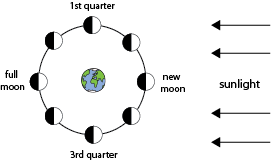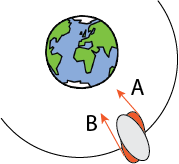The Moon
Our only natural satellite is a rocky almost spherical object without atmosphere or magnetic field. It has no obvious water although NASA recently announced evidence of water even though whatever area is sunlit has a temperature sufficient to evaporate water. The moon is much smaller than the earth and has a gravity of about 1/6 th of the Earth’s gravity.
The two most noticeable things about the moon are:
- The visible shape changes as we go through a month. These are called the moon’s phases.
- The moon (very nearly) always keeps the same face towards the earth. We never see the “dark side” of the moon.
- The moon is covered in craters
Here are the explanations of these.
1. The phases of the moon.

As the moon goes round the earth half of the moon’ surface is always illuminated, but we see only part of what is lit up. The diagram below shows this. At “first quarter” the illustration shows we only see half of the illuminated surface.

When the moon is on the opposite side of the earth from the sun then all of the moon’s illuminated surface is visible. This the “full moon”.
In other positions during the month the visible area changes as shown by the strip of photographs.
(The scale of this drawing is very wrong as the earth and moon are very mush small on this scale than illustrated. This means that only rarely does the moon go into the shadow of the earth. When it does, this is a lunar eclipse.)
2. Why we always see the same face of the moon.
First it is a good idea to understand why the moon produces tides on the earth. The moon’s gravity decreases with distance from the moon. So the pull of the moon’s gravity on the ocean water facing the moon is greater than its pull of gravity on the ocean water on the opposite side of the earth. This means that the water nearest the moon rises. The water on the other side of the earth also rises as the weaker moon gravity allows the water a slightly greater tendency to “fly off at a tangent”. So the ocean water rises slightly on opposite sides of the earth giving rise to the two tides a day we experience.
Now way back when the moon was forming it would have been subject to the same tidal effects from the earth’s gravity. So instead of gravity pulling the components of the moon into a perfect sphere the tidal effects caused the moon to be very slightly oval when looking down on the containing the moons orbit. This is the key to understanding the effect of “tidal locking” which is what keeps us looking at the same lunar surface. Here is how it works.
The diagram shows an exaggerated picture of the earth moon system drawn nowhere near to scale.

If the moon were to wobble away from keeping the same face to the earth, as shown in red, then the force of gravity from the earth on the bulge nearest the earth (force A) will be greater than the force on the bulge away from the earth (force B). This gives rise to a twisting effect (torque) that pulls the moon back to the position with the same side facing the earth.
The moon does indeed wobble slightly so we do see slightly more than one side of the moon. This effect is called libration.
The video below illustrates this. (With thanks to Wikipaedia)
3. Crater formation
Until comparatively recently it was thought most craters were volcanic in origin. However, in the 1870’s, the English astronomer Richard A. Proctor proposed correctly that the craters result from the collision of solid objects with the moon. But at first, few scientists accepted Proctor’s proposal. There is a difference in shape between calderas (volcanic) and impact craters. It is now pretty much universally accepted that the craters are caused by meteoric impacts. There is no atmosphere to burn up approaching meteors.
